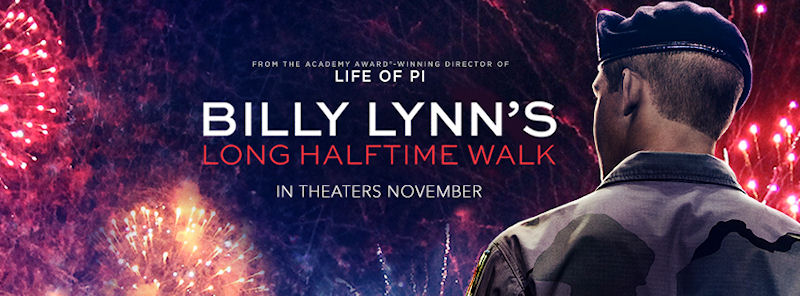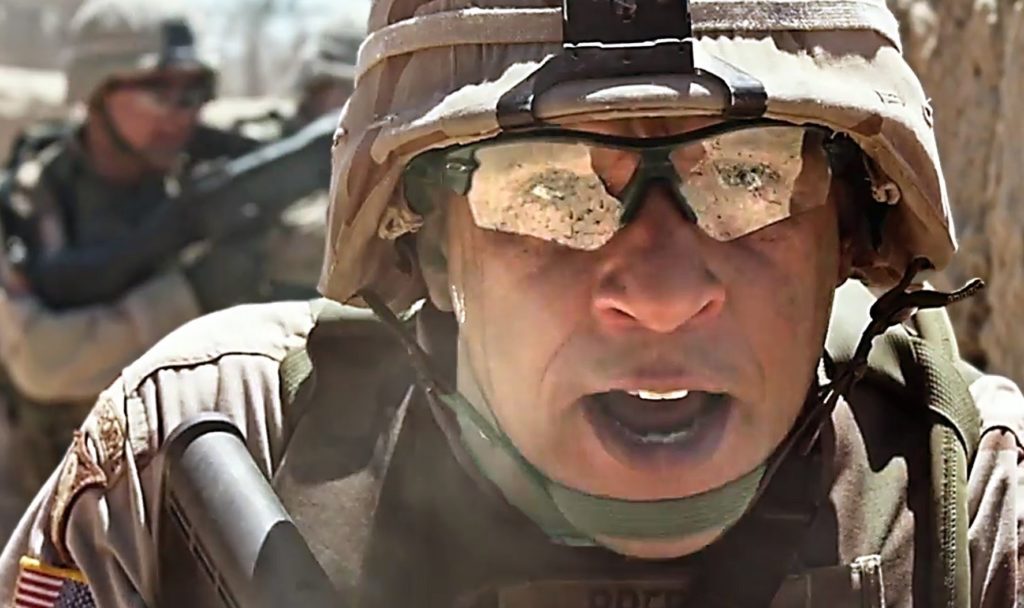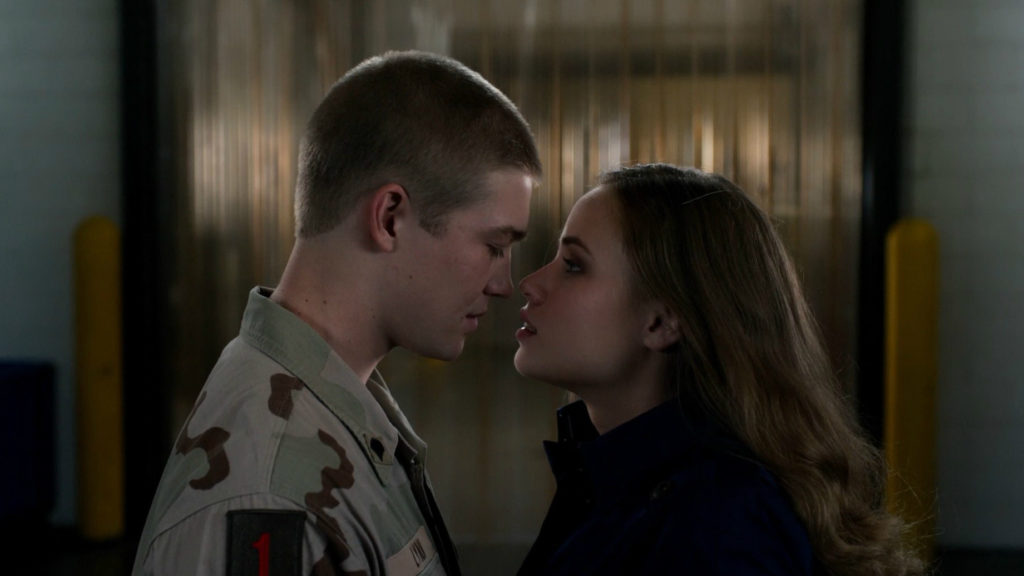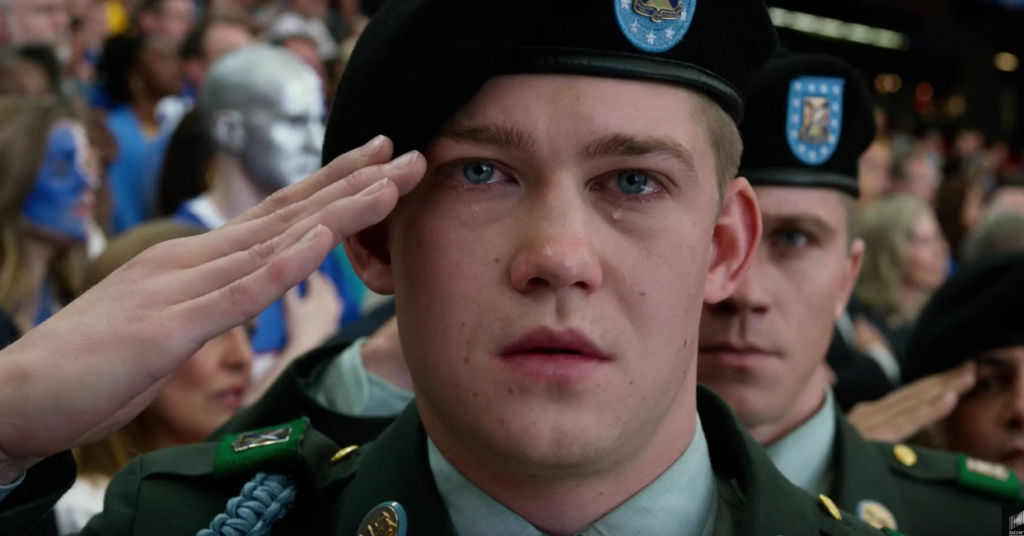I've Looked at "Lynn" from Two Sides Now
I was shocked and dismayed to read in The New York Times that in its opening weekend Billy Lynn’s Long Halftime Walk “took in a breathtakingly low $930,000 at 1,176 theaters.” Maybe it was the
competition (which included Fantastic Beasts and Where to Find Them). Maybe it was the timing, between a bruising election and the Thanksgiving holiday in the U.S. It seems to have everything one could want in a movie: war, heroism on the battlefield, family, religion, love, sex, food, exceptional vehicles, money, exotic venues, movie-making, crazy driving, sports, excess, guns, drugs, music, injury, passion, entertainment, death, philosophy, and beautiful young people, all directed by multiple-Academy-Award-winning Ang Lee. Oh, and there was also the technology.
In two U.S. movie theaters, Billy Lynn could be seen in 4K spatial resolution in stereoscopic 3D with 120 frames per second per eye and with higher-than-usual dynamic range (from brightest to darkest). That form of exhibition required new servers (to handle roughly 40 times the information of a regular movie), new projectors, and even new screens. In other U.S. theaters, it was seen conventionally (elsewhere in the  world there were other possible combinations of spatial resolution, depth, frame rate, and dynamic range, not to mention sound). I have now seen both the “super” and “regular” U.S. versions (in that order). I saw the super version from near the rear of the auditorium and the regular from near the front, in both cases in the center of the row. In both cases, I attended free of charge (not for anything to do with the movie), and, in both cases, the director was there, too.
world there were other possible combinations of spatial resolution, depth, frame rate, and dynamic range, not to mention sound). I have now seen both the “super” and “regular” U.S. versions (in that order). I saw the super version from near the rear of the auditorium and the regular from near the front, in both cases in the center of the row. In both cases, I attended free of charge (not for anything to do with the movie), and, in both cases, the director was there, too.
As best I can tell, everything above is factual. There has been a great deal of discussion of the sensation of seeing the movie, however, so I thought I would add my personal feelings about what I saw. As what I saw was directed, let me begin with a thought experiment. Think of your three favorite movie directors of all time. Now think of your favorite movie by each of those directors. Finally, consider what you might have thought of each of those movies had it been directed by one of the other two. If you’re like me, that last thought experiment might produce less than positive results. Different directors have different ways of doing things. It’s not possible for me to consider the technology separately from the direction, but, having seen both the super and regular versions, I can note differences.
I thought both the super and regular versions of Billy Lynn were very good movies, but I also felt they were different movies. The plot was clearly the same, but watching the super version I had the sensation of being a fly on the wall, observing the action; watching the regular version I had the sensation of watching a movie.
Seeing the super version, I had a visceral reaction. I thought that might have been due to the technology’s making the battle scenes seem more realistic. Perhaps it did, but I didn’t feel the battle scenes were that different in the regular version. Maybe they were still raising my adrenaline level; maybe, because I have never experienced military battle, I couldn’t tell which version of those scenes seemed more realistic. Football players on their field were noticeably more realistic to me in the super version, and there was noticeable (but not particularly objectionable) motion judder in the regular version, but those scenes didn’t evoke that different a sensation from me, either; I’m not a football player, and what happens on the field during the game is not central to the plot.
Rather, to my surprise, it was moments with low motion and seemingly low significant detail and low dynamic range that seemed most different to me: the love scene above, scenes in an ordinary home, in a conference room, in a dining hall, etc. Watching the super version, I felt better able to understand the emotions of the title character. And he seemed younger to me in the super version, too.
There was one scene I preferred in the regular version. It was the second scene of the movie (and the first to be shot), so maybe I wasn’t yet accustomed to the super-version look, or maybe the production team was not yet accustomed to capturing it. And there was a scene near the end of the movie that I much preferred in the super version. It was shot unusually, but in the super version the point of the unusual shooting seemed clear; in the regular version it seemed to me somewhat intrusive.
If you’re anywhere near either of the movie theaters showing the super version, I highly recommend attending. Whatever you might think of the movie, it’s important to determine what you think of the new technology.
Tags: 120-fps, 4K, Ang Lee, Billy Lynn's Long Halftime Walk, fly on a wall, HDR, like being there, motion judder, S3D,





2 comments
Both versions of this movie were in stereoscopic 3D. A major difference in the visual impression perceived depends upon the viewing distance from the screen.
If you were to wear the 3D viewing glasses while walking down the aisle toward the screen, you would see a marked difference in the image from the front row as compared to the back row. In the back, the proportions from the closest object in the image to the furthest object in the image will appear more than they should be relative to the lateral or vertical proportions. That is, everything on the screen will appear “stretched”, or elongated along the Z axis, as compared to the horizontal and vertical proportions along the X and Y axes.
As you approach the screen, they will appear more-and-more normal until somewhere in the middle of the auditorium, where the X, Y, and Z axes will all appear to be “normal”, that is, proportioned equally to each other. This is called the “Ortho stereo position”.
As you pass this point, and keep getting closer yet to the screen, the proportions along the Z axis will appear to be less than the proportions along the X and Y axes, and all parts of the image will seem to be more “squashed”, or flattened, along the Z axis.
Actually, this is an illusion created by the variable magnification (size) of the image due to the viewing distance, and the variable amount of disparity difference due to the metric of the position of homologous points on the screen being located on the eye retinas, as visually compared to the fixed interpupillary separation of the optical centers of the pupils of the eyes. At different viewing distances, the noted proportion variances will occur because of the difference of the disparity changing by less than the magnification difference of the X and Y axes. In actually, you see “greater depth” closer to the screen, but it seems to be the reverse, because the magnification of the screen image increases by a greater amount than the magnification of the disparity as perceived by the eyes at a fixed spacing.
Therefore, a person sitting in the front row of any 3D movie is seeing a very different movie than someone in the back row of the same auditorium viewing the same 3D content, whether “regular” or “super”. In order to fairly compare other attributes, such as HFR (frame rate), HDR, (gamma/contrast/brightness), resolution, color values, etc., it is necessary that both experiences are viewed on the same screen size from the same viewing distance from the screen.
Actually, in the U.S., the regular version was not 3D.
The comments are closed.